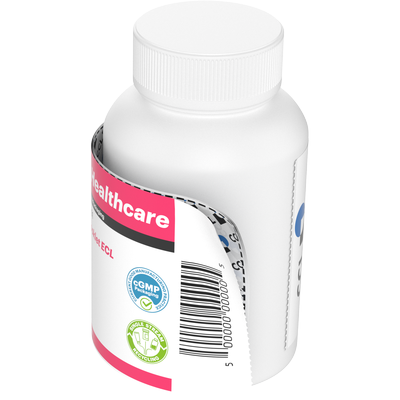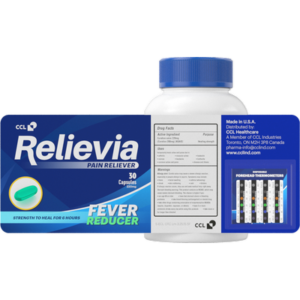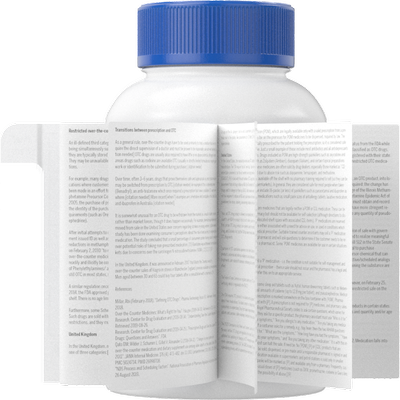The Benefits of OTC Booklet Labels
ECL's
We’ve all heard of over-the-counter (OTC) medications, did you know large portion of medication found at the pharmacy utilize an OTC booklet labels? In this article we will discuss the benefits of OTC Booklet labels.
OTC Medication are a popular and common choice for people seeking relief from minor health issues such as headaches, mild colds, heartburn, and indigestion. But with so many options available on to consumers, it can take time to know which product is the right product. That’s where over-the-counter (OTC) booklet labels come into play. Not only do they offer customers helpful information on the medication they are about to take, but they also play an essential part in their overall safety.
Expanded Content Booklet Labels Defined
Expanded content labels are known by a few names. They are referred to as extended content booklet labels (ECL booklet labels), booklet labels, or even OTC booklet labels. Regardless of the name, these labels have an integrated booklets and are essentially brochures that are attached to the
 outside of medication bottles or packaging. OTC expanded content labels contain additional information about an over-the-counter medication beyond what is required by law to appear on the primary label. These labels typically come in the form of a folded booklet and leaflets that are attached to the ou
outside of medication bottles or packaging. OTC expanded content labels contain additional information about an over-the-counter medication beyond what is required by law to appear on the primary label. These labels typically come in the form of a folded booklet and leaflets that are attached to the ou
tside of the medication’s packaging, such as a bottle,
tube, jar, or box. The booklet may feature additional colors or graphics within the booklet creating a better consumer experience. The label itself is pressure sensitive label allowing you to have full graphics and embellishments giving you packaging stopping power at the shelf.
What Is The Main Purpose of OTC Booklet Labels?
The main purpose of OTC expanded content labels is to provide consumers with more detailed information about the medication they have purchased. Another primary function of these labels is to comply with FDA requirements or other regulatory guidelines. The additional information on these labels can 
Common OTC Booklet Label Features
You will most likely find expanded content labels on everyday medication, such as children’s flu medication, pain medication, antiacid medication, creams, and much more. over-the-counter booklet labels are highly customizable and can come in various designs to fit different needs. They can feature a full graphic design with embellishments, printed with colors inside, and display
graphics. Additionally, they can be double-sided to show front and back labels or even include promotions and coupons. Expanded content labelsare usually releasable, meaning they can be opened again and again by the customer without being destroyed. These labels can be die-cut to just about any package size and can be designed to fit odd-shaped bottles. Depe
nding on needs and budget, there are also multiple printing options available such as thermal transfer and hot stamping. They are also versatile enough to be used on low-count or travel-size OTC medication. While design and layout can vary from medication to medication, the most critical aspect is that they provide clear and easy-to-read instructions and warnings.
Common Booklet Label Types
Just as there are many features to an OTC expanded content label, there are also many types of labels from which to choose. Some are better suited for sharing information, while others are more accessible to the customer. While booklet labels can range from two pages to over 10+ pages, most booklets are around two to six pages in length. The opening tab of the label can be placed just about anywhere on the label, such as the top, bottom, or center. Today, there are many types of ECL’s but two popular and common label types are leaflet and booklet labels. Each type offers multiple subtypes or constructions to suit just about any pharmaceutical need.
Main Benefits of Expanded Content Labels
Overall, OTC booklet labels offer, or OTC expanded content labels, a great way to add additional information and enhance the branding of a product. But there are many practical reasons to use these labels for both the consumer and the pharmaceutical company.
Improved Consumer Understanding
One of the primary benefits of OTC expanded content labels is improved consumer understanding. By providing more detailed information about a medication, consumers can make more informed decisions about their health. The expanded content labels can help consumers better understand the potential risks and benefits of a medication, as well as any precautions or warnings that they should be aware of.
Increased Safety
OTC booklet labels can also help increase safety for consumers. By providing additional safety information, such as potential side effects and warnings about drug interactions, consumers can better understand how to use a medication safely and effectively. This can help reduce the risk of adverse reactions or other safety concerns.
Greater Convenience
Another benefit of OTC booklet labels is greater convenience. On the business side, they increase the space a pharmaceutical company has on the bottle or package. Companies can save money since they won’t need bigger bottles or additional printed inserts in the box. Consumers can easily access the additional information they need about a medication without having to search for it online or in other sources. The long-lasting labels also mean the information will be accessible for the life of the packaging. OTC booklet labels are design to be opened and resealed with the robustness to handing the everyday shopper browsing through the booklet and returning to the shelf in perfect condition. For consumers, this access to information can help save time, reduce confusion, or harmful drug interactions when selecting and using OTC medications.
More Personalized Information
OTC booklet labels can provide more personalized information about a medication. For example, the booklet may include information on how to use the medication for specific health conditions, age groups, or dosing information by weight. This can help consumers better understand how to use the medication in a way that is most effective for their individual needs.
Improved Compliance
Medications are subject to numerous regulations that must be reflected in their packaging and labeling. Compliance with these requirements often requires manufacturers to include a significant amount of text, which can be an issue when dealing with limited space on pill bottles or small packages. OTC booklet labels can help solve this issue. The extra space can be used to provide additional information, promoting consumer trust and safety. Manufacturers can comply with any regulations while also providing consumers with other information that is needed for their safety and well-being. By providing more detailed information on how to use a medication properly, consumers can better understand the importance of following dosage instructions and other safety precautions. This can help improve compliance with medication instructions and help build trust with the consumers.
Maintain Branding
With various options available for extended product content labels, pharmaceutical companies can choose labels that not only meet regulatory requirements but also preserve their branding. Since OTC booklet labels offer more “real estate” to contain this information, there is more room to meet regulatory requirements without losing space for a logo or name. OTC booklet labels can be used to support marketing efforts or just engage more with a customer. The added area even offers brands the opportunity to print in multiple languages. QR codes can also be included in expanded content labels to provide consumers with more information about the medication or promotional offerings available.
Product Packaging Flexibility
OTC booklet labels are versatile and can work with a variety of primary packaging types. These labels can also be used with folding cartons, liquid medication bottles of all shapes and sizes, and even containers with shrink sleeves. Their ability to be customized and die-cut to various shapes makes them a popular choice for unique or complex packaging options. With the flexibility to work with multiple primary packaging types, OTC booklet labels provide an excellent solution for displaying necessary information and enhancing the branding of a product.
Choosing Expanded Content Labels
Whether you call them OTC booklet labels or over-the-counter expanded content labels, these small pieces of paper are an important tool for helping consumers make informed decisions about the medications they are using. By providing additional information beyond what is required on the primary label, these booklet labels can help consumers better understand the potential risks and benefits of a medication and ultimately lead to a safer user experience. With so many options to choose from, understanding regulatory requirements is important for selecting the right label type. Another option to consider is the type of message or instruction that needs to be shared with the consumer. Will the customer reference the information frequently? Will they need information in multiple languages? Will the label contain only text, or will it include graphics? No matter the requirement, there is likely an expanded content label that is the proper shape, size, and fit for any over-the-counter medication.
